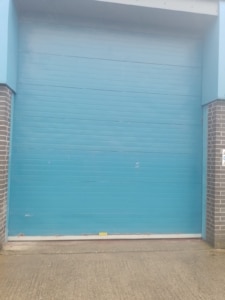What Is A Sectional Door & Things That Can Break
A sectional door is a specialised type of door commonly used in industrial settings and warehouses. At its core, it consists of multiple horizontal panels, or sections, connected with hinges. When the door is operated, these panels move vertically along tracks, bending over a curve and eventually settling horizontally along the ceiling of the structure, parallel to the floor. This mechanism makes sectional doors particularly versatile and space-saving.
For industrial and warehouse purposes, sectional doors are ideal for several reasons. Firstly, they offer a tight seal, ensuring that the internal environment remains consistent, which can be crucial for warehouses storing sensitive goods or materials. The vertical operation means that vehicles or equipment can be positioned right up to the door, maximising space usage. This is in stark contrast to traditional rolling doors or swing doors, which might require additional space for operation.

The robust construction of industrial sectional doors ensures that they are durable and can withstand the rigorous demands of busy warehouse environments. They are often constructed using high-quality steel or aluminium, sometimes with insulation layers, making them sturdy and energy-efficient. The segmented design also means that, in the case of minor damages, individual panels can be replaced without needing to change the entire door.
Another significant advantage of sectional doors for industries is their adaptability. They can be customised to fit a wide range of sizes and can be integrated with windows or pedestrian doors. Furthermore, these doors can be manually operated or motorised, depending on the frequency of usage and user preference.
In essence, a sectional door for industrial and warehouse applications offers a blend of functionality, durability, and space optimisation, making it a popular choice for businesses prioritising efficient operations.
Things to Consider When Repairing A Sectional Door
Fixing a sectional door involves addressing a variety of potential problems, from simple to more complex. Here’s a step-by-step guide on how to diagnose and fix some common issues:
Safety First
Before attempting any repairs, unplug the automatic door opener (if you have one) to ensure it doesn’t activate while you’re working. Always wear gloves and safety goggles to protect yourself.
Diagnose the Issue
Door Won’t Open or Close
This could be due to an obstruction in the tracks, a broken spring or cable, or issues with the door opener.
Door is Noisy
The rollers might be worn out, or there might be an issue with the tracks or hinges.
Door Doesn’t Seal at the Bottom
The door seal (also known as the astragal) might be worn out and need replacing.
Door is Off the Tracks
The door might have been hit or misaligned, causing it to go off the tracks.
Inspect the Parts
Rollers
Check for signs of wear or damage. If they’re worn out, replace them.
Hinges
Ensure they are securely fastened and not damaged.
Tracks
Look for any dents, bends, or obstructions. Clean the tracks of any dirt or debris.
Springs
If they’re broken or look worn out, they will need to be replaced. Remember, torsion springs are under high tension, so replacing them can be dangerous and might be best left to professionals.
Cables Inspect for fraying or damage. Replace if necessary.
Tighten All Hardware
Over time, the hardware of a sectional door can become loose. Use a socket wrench to tighten bolts and screws.
Replace Worn-Out Parts:
If the rollers are worn out, replace them with new ones.
For a damaged astragal, remove the old one and install a new one according to the manufacturer’s instructions.
Replace any damaged or missing hinges.
Realign the Door:
If the door is off its tracks, carefully realign it. It might require you to loosen the brackets securing the tracks and make adjustments.
Use a level to ensure tracks are straight.
Lubricate Moving Parts
Using a silicone-based lubricant or garage door spray, lubricate the rollers, hinges, and springs. This reduces friction, noise, and wear.
Check the Door Balance
Disconnect the automatic opener (if applicable) and try to lift the door manually. It should lift smoothly and stay open around three or four feet off the ground. If it doesn’t, it might be out of balance, indicating spring issues.
Reconnect and Test
If you’ve disconnected the automatic opener, plug it back in. Test the door several times, ensuring it operates smoothly.
If you’re ever unsure about a repair or if the problem seems beyond your expertise, especially when dealing with high-tension components like torsion springs, it’s essential to contact a professional. Garage and sectional door repairs can be dangerous, and ensuring safety should always be the top priority.
If you are looking for a quality fast repair service for your sectional doors, roller shutters or automatic doors in the North West then UK Doors & Shutters are the premier go-to company. With over 25 years in the industry and a team of quality installers of rollers shutters we can provide the support you need to keep your shutters and doors functioning to minimise business downtime.






Leave a Reply
Want to join the discussion?Feel free to contribute!